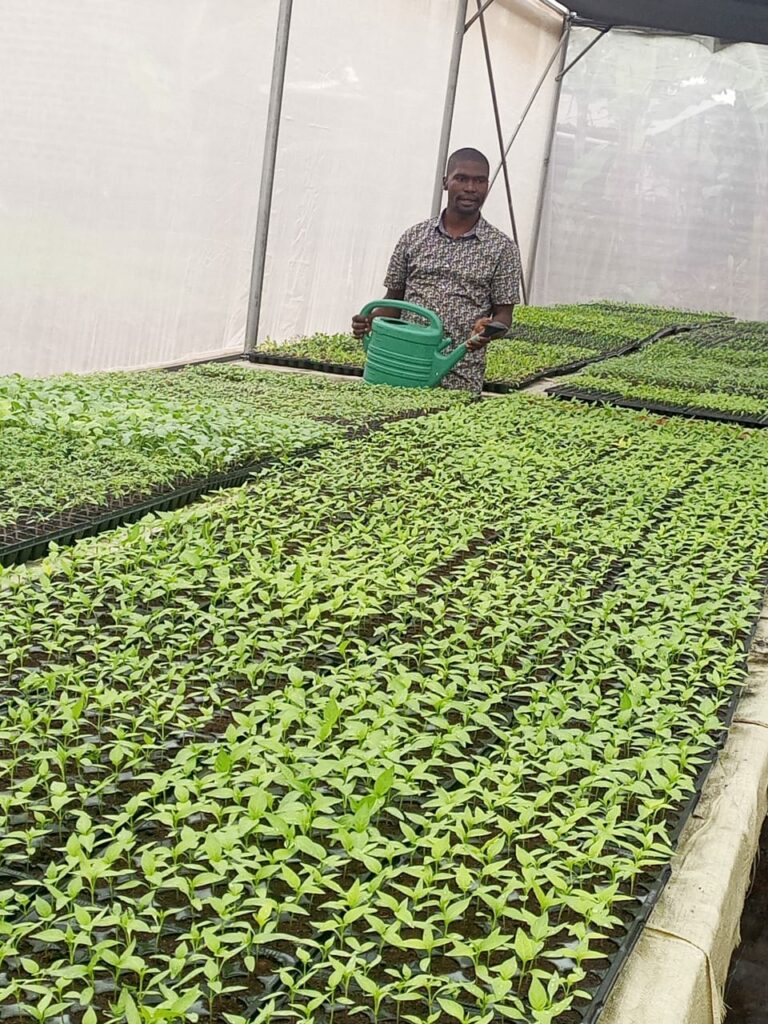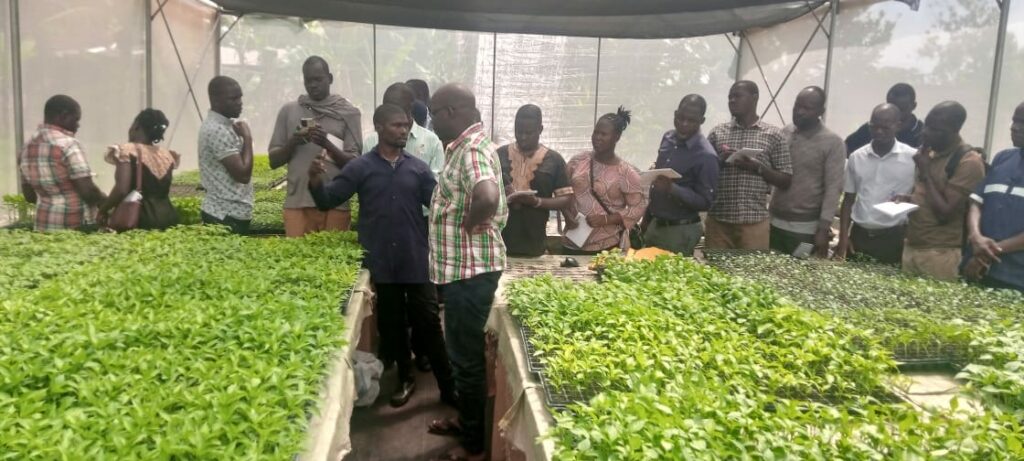By Joshua Kato
There are over 29 women of different ages picking green chilli. Each of them has a basin where she places the chilli she has plucked from the plants. Located on the Kyabakadde-Busiika road, Mukono district, Mike Ssegawa’s farm is a source of income for many of these women.
“There are 10 acres of chilli,” Ssegawa says. He hired the land. “I am showing fellow youth that a lack of land should not stop one from farming. I have been growing chilli here for three years,” Ssegawa says. In addition to this farm, Ssegawa has got a greenhouse at Nakifuma, Mukono district, which he uses to propagate vegetable seedlings. The other vegetables he grows include green pepper, egg plants and cabbages, among others.
Although he grows a variety of vegetables, chilli or hot-pepper is his major cash cow.
“Recently, there has been a tremendous increase in the production of hot pepper due to high demand in the export markets,” Ssegawa, He has been growing and exporting chilli for six years.
Ssegawa explained that there are several markets in Europe and Asia for Ugandan chilli. Countries that take Ugandan chilli include Netherlands, India, China, Saudi Arabia, UK etc. “These markets are open as long as one keeps the right standards,” he said. He hinted that standards target mainly hygiene of the product and chemical residues.

Starting out
Ssegawa started his farming journey in 2008. “It was the rudimentary way of farming, no serious knowledge. So, I later decided to go and study agriculture,” he says.
He picked Bukalasa. However, when he completed a diploma in agri-business from Bukalasa Agricultural College, Luwero district, in 2015, he straight away changed from casual farming into commercial farming.
“I did not own land, and I started by hiring it,” he says. At this site in Kyabakadde, he has so far hired it for three years.
“I have got money here that I have used to acquire other pieces of land including the one in Nakifuma that has my green house,” he says.
But before he started, he visited other farmers to see and learn more about this vegetable farming business. One of the farmers he visited was Joseph Male, of Magere, near Kasangati, Wakiso district, a best farmer in 2019.
“Male took me through the depth of being a commercial vegetable farmer. I applied the knowledge on my farms,” Ssegawa says.
He bought the first seeds from Holland Greentech, a Dutch company and started multiplying them for planting on his farm.
“At first, I was growing the vegetables for the local markets, for example, Kalerwe and Nakasero, however I realised that prices were not good. I then opted for the export markets,” he says.
Getting export certificate
Segawa exports his vegetable produce to various countries in Europe, including Netherlands. He explains that it took him several attempts before he was finally allowed to export.
“When I contacted the companies that I am supplying my vegetables, they asked that I must have my farm certified for export,” he says. He applied to Ministry of Agriculture Animal Industry and Fisheries (MAAIF) for the certification.
“They visited my farm several times. They checked how I applied the farm chemicals, checked for chemical residues before they finally granted the certificate,” he says. His export certificate is UG/106/40058. “This is renewed every three to six months,” he says.
Because the product is for export, the entire process, through harvesting is carefully executed. “We have to pack the chilli carefully so that they are not affected in anyway. We also mind a lot about the chemicals that we use in order to avoid leaving residues,” he says.
Ssegawa emphasizes that hygiene, right from planting, management and packaging is very important for a farmer growing vegetables for the export market. “There are specific farm chemicals that I use. These are recommended by the consumers in Europe,” he says. The workers must also be clean all the time.
“My products have never been rejected by the exporters because I respect the set standards,” he says.
Where the money is
There are two seasons per year. In the first season, he gets four to five tonnes per acre. In the second season, he gets three tonnes per acre. Harvests drop in the second season. At any one time, he has at least five acres under harvest.
He sells a kilogramme of green chilli at sh3,000, while a kilogramme of red chilli goes for sh5,000.
“When we dry it, a kilogramme goes for sh8,000,” he says.
He however prefers harvesting and selling the green chilli because it enables the plants to produce faster. “When you remove the chillies early, the plants react by producing new chillies hence earning more,” he says.
Overall, an acre generates about sh6.8m per year.
Other products
In addition to the chill growing, Ssegawa also propagates vegetable seedlings for sale.
“One of our new innovations is that we are now able to use grafting in vegetable seedlings production. This is a new practice but it produces cleaner and tested seedllings compared to directly planting seeds,” he says.
Ssegawa is able to produce at least 70,000 seedlings per year. At sh300-sh400 per seedling, gross earnings are about sh21m per year. Ssegawa also grows hot pepper and Okra.
Seeking more knowledge
Ssegawa continues to attend trainings in vegetable farming in order to improve his practice knowledge. “I regularly attend trainings including those organised during the annual harvest money expo. Additionally, I also organize farmers trainings at our green house in Nakifuma with the objective of sharing and giving out knowledge to fellow farmers,” he says.
Value addition
Ssegawa says that chilli can be processed in several ways. Among these include powder, chilli sauce, concentrates etc. “We are exploring at starting producing powdered chilli. It is a process that we have started on because we realize it will be one way of increasing the shelve life of our product,” he says. Among the equipment that he requires is a dryer and packaging materials.
Family involvement
Ssegawa`s children are still young and are not so directly involved in farm activities. However, his wife steps in whenever hygiene and sanitation issues arise.
“My wife has a medical background so she is not directly involved in the day-to-day activities of the farm. However, she advises on health issues especially since certifying officers have to visit the farm every three months,” he says.

Communal impact
Ssegawa employs casual workers who are mainly from the village – Kyabakadde. “They come every harvest day and earn an income. I pay each of them sh300 for each kilogram harvested.
On average, each of them harvests at least 20kg per day,” he says.
Harvests are done at least twice a week. Additionally, there are three permanent workers who operate on the farms. These look after the green house, including making sure that seedlings are watered daily.
In addition to paying the workers, Ssegawa is also encouraging them to start growing the vegetables in their homes, both for domestic consumption and for some money. “There are many who are now growing vegetables for example cabbages, green pepper, egg plants and are earning some money,” he says.
Ssegawa gets his workers from the community around him. “I then train them so that they can implement what I need. Of course some of them move on, but I replace,” he says.
Ssegawa also has 23 out growers in the areas of Mukono, Wakiso and Kayunga. These include 12 women and 11 young men.
Achievements
“The fact that I am a full time farmer is actually a very big achievement. There are many young people looking for jobs, but for me I decided to be a farmer,” he says. He explains that he has been able to buy land and expand his farm. “I bought the land in Nakifuma using earnings from farming. I am able to live a decent life because of farming,” he says.
Challenges
Ssegawa says that one of the challenges is proper transportation of the produce to the exporting companies. “I have a tuk tuk that I use sometimes, however I also hire a box body cooling truck. It is a bit expensive at the moment,” he says. He says that using a refrigerated ideal.
He also complained about fruit flies that attack the chilli. He says that if they are not handled properly, they can destroy an entire harvest. “I am using yellow fruit fly traps to control them,” he says.
How he grows chilli
Ssegawa said there are over 160 varieties with each variety having value on the export market. However, the commonest varieties are habanero, scotch, birds eye, bullet pepper, cayenne, green bell pepper and black pepper.
Chilli takes five to six months to reach maturity. “If they are well-maintained, with enough watering all through, they can last five years,” he said
Ssegwa says the crop requires well drained soils with a soil pH of around 5.5. “To get the right Ph, carry out a soil test. Fortunately, there are now many companies that can test your soils,” he said. To ease the process, Ssegawa says he acquired a portable soil tester. Commercially, a test costs between sh30,000 and sh50,000 per sample. An acre needs at least three samples.
What others say
Sarah Nabweteme, one of the ladies who earns from harvesting chilli says that the money earned helps her solve domestic challenges. “I am able to buy basic needs like soap and sugar,” she says.
Marble Kitaka, “I have started growing vegetables thanks to knowledge and inspiration that I have got from this farm. I am still practicing on a small scale but I will expand. I sell my harvests to people around Nakifuma,” she says.
Joseph Male, farmer, Luteete, Wakiso, “Ssegawa is one farmer who takes keen interest in details at his farm. Growing vegetables for export pays well but it has got a lot of challenges which can only be overcome if a farmer understands and implements the set guidelines,”





